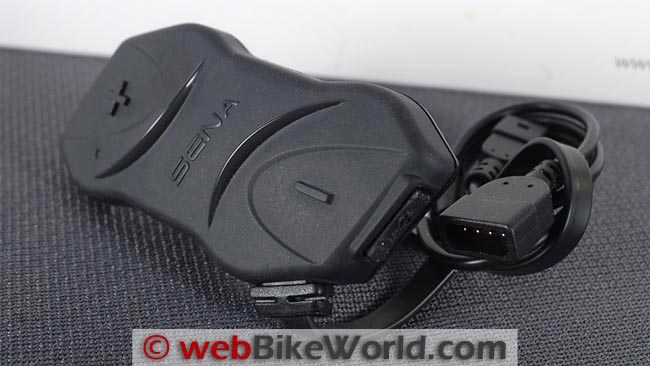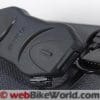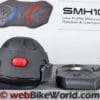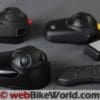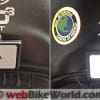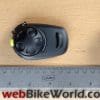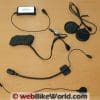The Sena SMH10R Bluetooth headset is a very different type of motorcycle helmet intercom system.
Instead of the traditional single intercom module that attaches to a helmet mount, the SMH10R intercom functions are split across two separate modules.
One module houses the Bluetooth “brains” and the rider control buttons, and a second module holds the battery.
This results in an intercom system that has a low profile and is much thinner and easier to install than most motorcycle helmet intercoms.
Both modules are mounted to the helmet using the supplied adhesive.
Distributing the intercom system between the two modules has allowed Sena to greatly reduce the physical profile of the helmet with intercom.
The stereo speakers, microphone and battery are then connected to the SMH10R Bluetooth module with ruggedized and weather-proof keyed mini-connectors — no muss, no fuss.
With performance virtually identical to that of its older sibling, the Sena SMH10B (review), the SMH10R is lighter, smaller and far easier to install compared to many other systems on the market.
And that traditional helmet mounting bracket isn’t missed one bit.
But the much smaller size of the SMH10R means that the unique Sena “Jog Dial” to control the intercom is gone.
In its place is an enhanced spoken status announcements voice menu system, which fortunately makes short work of learning which button to push in what sequence to get systems and peripherals paired for optimum performance.
All the good stuff Sena provides via firmware is included in the new SMH10R however, along with interoperability with all other Sena intercoms and communication systems.
So for many applications and many consumers, myself included, Sena has another winner.
Sena SMH10R Overview
Observation 1: The Sena SMH10R includes a distinctly shaped thin Bluetooth module, with wire and boom microphone components nestled in the top layer provide great visual impact.
Observation 2 : What, no Jog Dial? Nope.
The intent was to provide a lean, lightweight fully modular system that could find a home on any helmet of almost any form and be very unobtrusive to boot.
Also, the SMH10R does not have the auxiliary input port found on the SMH10B.
Observation 3: Sena’s pursuit of standardization and quality assurance shows very well between all their systems. Sleeve and box markings are uniform and informative with internal packaging efficient and effective in its presentation. “First impressions count.”
The next layer includes a thick well written and richly-illustrated manual.
Also included is a double-sided coloured handout with the SMH10R Configuration Menu diagram on one side and a Quick Start Guide on the reverse; concise, foldable and storable.
A complete Sena SMH10R kit includes:
- The Sena SMH10R Bluetooth Low Profile module with flat cable connection harness.
- Two microphones, boom and thin wire, with modular dual-pin connectors.
- Large version dual speaker stereo headset with four-pin modular connector.
- An external battery module with two-pin modular connector.
- A 12V DC NA-style charger with mini-USB connector; USB charge/data cable, Type A to mini-USB connectors.
- Various shaped pads for mounting the modules, speakers and microphone.
Sena claims that the new intercom module is “only slightly thicker than a US quarter”.
But in (measured) reality, it’s more like three (or four) stacked quarters, given the raised edges and buttons on he intercom. But hey — it’s still very thin.
There is no disputing that the SMH10R module is on par with the smallest and lightest Bluetooth helmet modules webBikeWorld has reviewed.
This includes the HuRob HSB100B and the older (but ahead of its time) AKE Stealth 200 intercom, another fully modular external-battery based system.
Contributing to the lean and efficient look of the Sena SMH10R is the flat cable lead from the Bluetooth module.
It ends in three mini-connectors: four-pin for the large hi-performance headset (common to the SMH10 models) and two-pin connections for the microphone and battery.
The keyed connectors are designed to fit in one way only with their other half, simplifying the connections and preventing misalignment, as the pin connectors are thin and could be bent easily if the wrong connection was attempted.
Each connector also has a top orientation marking for alignment visually or by touch.
Lacking the popular Sena “Jog Dial”, the rider interface to the Sena SMH10R is provided by three tactile controls.
Pressing the Sena logo in the middle of the face surface activates the Centre button, with the other two Volume Up (+) and Down (–) controls located fore-and-aft of the Centre button respectively.
The Blue and Red LEDs are separate elongated curved inserts forming part of the left and right raised lines defining the three button areas.
The LED layout is aesthetically pleasing and in keeping with overall design of the module, although as usual they can be difficult to see in daylight.

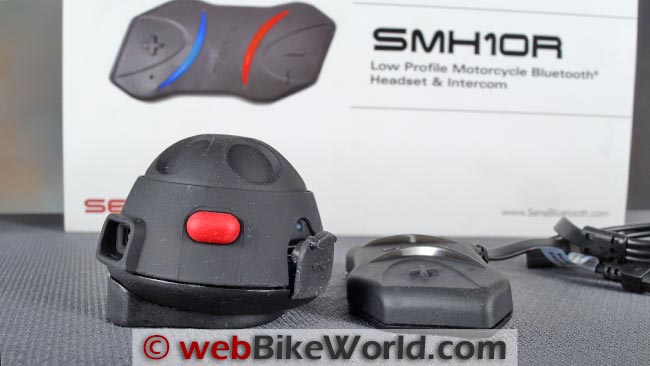
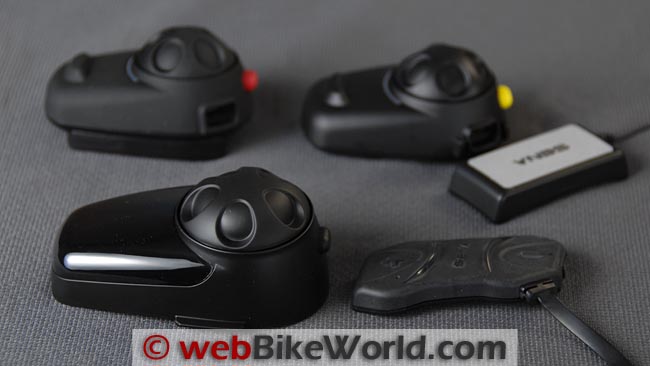
Installation Notes
Before diving into the first helmet, remember that the Sena SMH10R intercom system has two separate modules, one for the intercom controls and one for the battery.
Each is mounted directly to the helmet, with no traditional helmet mounting bracket required.
This makes the installation a bit more permanent, if you will, but it also results in a very low, clean and discrete installation.
I installed the SMH10R on two different helmets. First up was the flat black Arai XD3 Helmet (review), a near-perfect colour match for the touch-friendly matte black finish of the SMH10R module.
After visually determining where the Bluetooth module and battery would go, the speakers were installed in the left and right cheek pads.
They were secured to previously mounted 10 mm thick spacers placing each speaker a couple of millimetres from the ears.
The SMH10R kit includes two speaker pads for placement purposes, but the thicker 10 mm pads from one of the BikeComm BK02 (review) kits have been in place for some time supporting other headsets.
So they weren’t disturbed in favour of the thinner but appreciated Sena items (this type of “helmet tuning” accessory should be standard in every retail intercom kit).
Using the provided hook-and-loop pads, I mounted the Sena SMH10R Bluetooth module in the usual spot on the left bottom side of the helmet shell, while the battery was installed at the rear centre of the helmet on the edge of the helmet shell.
This is one of the most unobtrusive spots for mounting the SMH10R battery module, while also providing maximum visibility; the reflective material on the face of the module is extremely bright when illuminated.
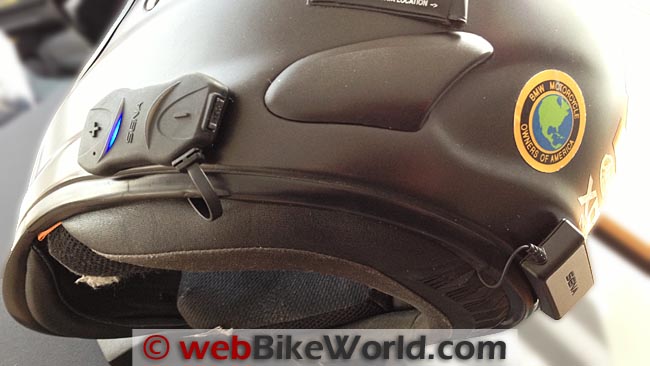
Sena SMH10R Battery Module
While thinking that the battery lead might need some additional protection, it can simply be (carefully) tucked under the soft molding along the bottom of the helmet leaving just a short section of it exposed, although out of the way.
Both the Editor and I had thoughts about whether the battery lead would be better exiting the bottom.
But after going through this and subsequent installations and with continued use, having the lead exit off the left side is logical (based on expected placement, working extremely well to eliminate possible lower edge clearance issues.
For the Nolan N-103 (review) and the SCHUBERTH C3 flip-up helmet (review), getting the SMH10R installed was straightforward.
Other than running the main flat wire harness a bit further back to get it routed inside the helmet, with the thin-wire battery lead run to the same point and both tacked to the bottom edge of the helmet for protection, I had no issues.
I did take the opportunity at this stage to slightly warm and then remove the 3M adhesive from the back of the two SMH10R modules so that shaped pieces of 3M Dual-Lock material could be used instead.
Virtually every helmet I own is now equipped with a matching patch, which makes migrating the two SMH10R modules (or virtually any other system) quick and easy — a two to three minute effort.
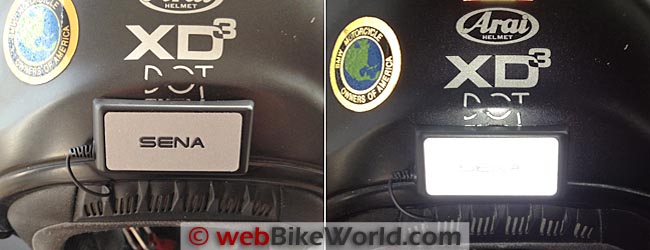
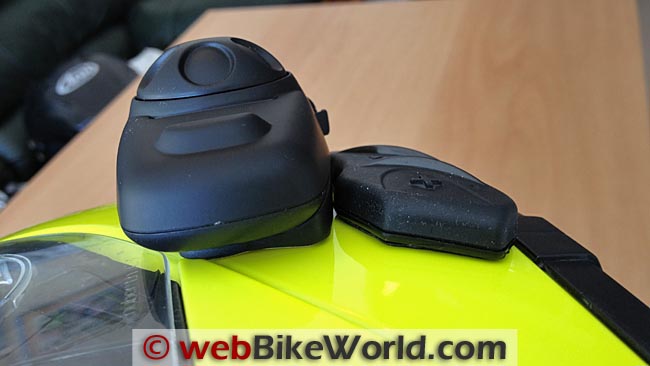
On the Road: Function and Performance
Some limited road time with a single SMH10R was provided during a few warm spells as winter loosened its grip ever so slightly up north.
And with a second SMH10R intercom on hand for use during early Spring riding (between snow storms) in Virginia, I have now used the systems extensively mounted on four different helmets and under varying riding conditions.
As for performance, the SMH10R is nearly identical to the “classic” Sena SMH10 (review), which has been extensively described, reviewed and commented on by webBikeWorld readers in that review.
Therefore, we’ll touch on the differences here only. Here is my report.
Controls
The Sena “Jog Dial” is missed, but appreciating and learning the ever-maturing voice command menu and using the supplied “cheat sheet” handout (U.S. version only apparently) gets everything paired using the general or Selective Pairing options in quick time.
After one or two rides, all is well.
Switching back to “three button mentality” mode isn’t a big deal.
But even with the front, centre and back sections clearly marked with the two dividers on the SMH10R Bluetooth module, finding and using the controls just isn’t the same as having that easy to find touch friendly Jog Dial and the distinctive Phone button.
Discerning the three controls while wearing light- to medium-weight gloves isn’t bad, but with heavy winter gloves or a three-finger design like the Rukka Lobster gloves (review), users are likely to have issues.
There is no complaint about sensitivity and input; just in finding the right button at the right time.
This issue — probably more subjective than objective — identifies what I see as the only compromise made by Sena with the SMH10R; that being the exclusion of its own best feature, the Jog Dial.
But again, one must appreciate design and purpose…but then again, a voice command system would be a very welcome capability for such a system as this.
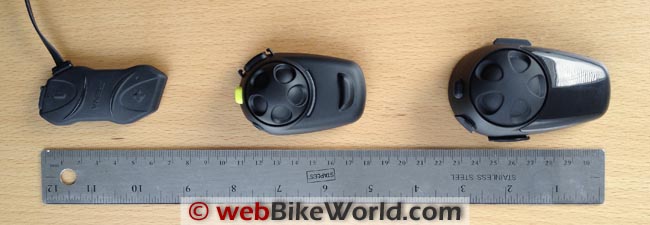
Device Pairing
As expected, the SMH10R intercoms pair with everything I tried, including the UClear WT300 (review) and Sena SR10 (review) Bluetooth adapters.
Also the Sena SM10 (review) audio sharing device and, of course, all of the Bluetooth Adapters reviewed recently on webBikeWorld.
Sena SMH10R Intercom
With the ever-growing Sena family of Bluetooth intercom communications systems, the question of compatibility is always raised.
But never fear, this isn’t an issue with Sena products; the intercom feature on the SMH10R works with all of the other devices.
And in reality, many feature differentials are largely being mitigated through enhancements applied to new versions of current models.
For example, the Sena SMH5-FM (review) that now connects with up to three other intercoms and has much greater range.
And speaking of range, 900 metres (980 yards) is the stated range of the SMH10R and it is a realistic one, with a working average of 800 metres to just around 1000 metres viable, given optimal natural and man-made conditions.
This puts the SMH10R intercom very close to its SMH10B sibling.
Sena SMHR10R Power and Battery Life
Once it is securely mounted on the helmet, the battery module half of the SMH10R shouldn’t require much attention unless it needs to be replaced due to failure or swapped out for a back-up unit.
The latter was a scenario that the Editor raised in wondering why the connector wasn’t placed closer to the battery.
A valid observation, but outside of needing to change the battery, I haven’t needed to access the connector or battery lead.
The system is recharged via a micro-USB port on the back edge of the Bluetooth module and like all other Sena systems the SMH10R can be used while recharging.
Battery life, as expected, is very good.
It’s always on the plus side of seven to eight hours, with perhaps a hour less with a heavy mix of music streaming and intercom use throughout a day’s riding.
AC recharging usually takes 60 to 90 minutes or somewhat longer when charging through the USB port from a computer. And again, using the intercoms while powered keeps everything at peak.
Storage and Handling
The benefits of the low-profile SMH10R intercom modules accrue during use and when carrying or locking the SMH10R-equipped helmets.
I can place the helmets in their protective carry covers or helmet bags without worrying about removing the system or the Bluetooth module first.
And the helmet or helmets now fit into most top cases without the usual height constraints typical when bulkier intercoms are attached to the helmets.
Both of my SCHUBERTH C3 helmets with the SMH10R intercoms installed easily fit into the SHAD SH48 top case (review).
Both of my Arai XD helmets with the SMH10R intercoms properly positioned can be safely stored in the SHAD SH49 top case.
And the Arai XD3 with the SMH10R now fits into a prototype square aluminum top-box, something I can’t do with other intercoms installed due to clearances issues.
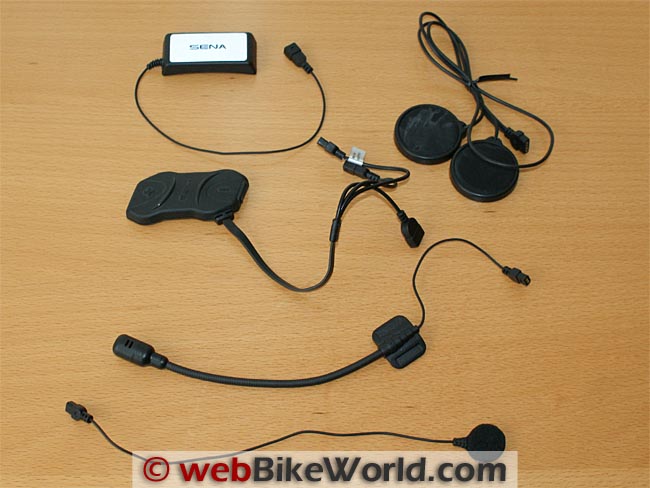
Sena SMH10R Bluetooth Headset Accessories
You asked for it — you got it! Replaceable batteries for a motorcycle helmet intercom!
- An additional SMH10R battery modules for the SMH10R is ~$17.00; keep a spare charged and ready to go.
- A Sena slim speaker kit for the SMH10R is also available, around $25.00.
- A Sena large speaker kit for the SMH10R is available (not sure what the difference is); also ~$25.00.
- A spare set of mounting pads and adapters “Supplies Kit” for the SMH10R is also available for $6.95.
Conclusion
I miss the Sena Jog Dial found on other Sena intercoms, but this is really just a sign of personal over-dependency on what is I have come to regard as the most functional feature of any Bluetooth helmet system going.
Using one, two, three or more button layouts is both a matter of mental and physical adaptation; with the former typically easy and the latter, well, not so much — particularly when heavyweight gloves are worn.
Despite my nit-pick with the controls, that isn’t actually a new issue as most other systems still use a multi-button approach, there are real benefits in using the SMH10R, mostly related to its size and modularity.
Whether mounted using the supplied thin adhesive mounts or 3M Dual-Lock (adding 2-3 mm overall height), the dual SMH10R intercom modules hug the helmet shell with a very small footprint.
This form factor, with its modularity that facilitates component installation, and the size and performance of the SMH10R is outstanding, even though functionality is or can be slightly hampered by the three-button man-machine-interface.
But I can I and will live with this issue given all the other positives of the SMH10R.
More wBW Sena Intercom Reviews
Owner Comments and Feedback
See details on submitting comments.
From “J.L.” (May 2017): “I’ve had the 10R for a few months now, and I would like to add a few comments to the review.
One of the reasons I bought this system was the separate battery. I thought it would be easier to replace a dead battery.
What I did not realize was how much issues that 2-unit setup creates.
First, there are all the additional wires, which have to be carefully routed, hidden somewhere in the helmet liner, and velcroed in place. Then, the battery at the back of the helmet is another thing to watch for.
The battery is not well maintained in its bracket; gaffer tape works nicely, though. In other word, the separate battery causes more problems than it solves.
I have not been able to connect both a phone and a GPS to the 10R AT THE SAME TIME. Each of them connects fine individually, but not the two of them.
Now that I re-read the review, I’ll try your recommendations under “Tip: GPS Pairing” because, indeed, like you write, “the instructions aren’t quite clear.”
Also, pressing the buttons with gloves is difficult, as a user’s has already commented.
The hook on the back of the earphones does not grim my Arai liner very well, causing them to fall off basically every time I remove the helmet. But that is minor.
On the plus side, the sound is loud and clear and, during the sole phone call that I dared answer while riding, the other party had no idea I was not sitting at a desk!
There is no doubt that the number of wires connecting everything is a deal killer, in my opinion, though. Knowing what I know now, I wouldn’t buy it again, even though in terms of use, besides the GPS + cell phone issue, it works very satisfactorily.”
From “J.T.” (February 2014): “(The) comment was made by J.A. in May of 2013 (below), that the battery doesn’t need to be mounted outside at the back of the helmet and J.A. had tucked the battery inside his helmet.
That may be okay however the battery is a lithium/polymer battery which are susceptible to heat and heat buildup.
I suspect the maker had that in mind when they took it out of the primary (obviously making that package smaller as an added benefit) unit and placed it at the back of the helmet where it could get a bit of additional cooling. Just a thought.”
From “M.F.” (June 2013): “Thanks for your excellent review of the Sena SMH10R. Led to my buying one, plus extra speakers and mic for a second helmet.
My goal is to use the iPhone 4S for music and calls and a BT transmitter for a Passport radar detector. I don’t ride with a passenger, so multi-headsets not important.
From Amazon, I bought one of the small Bluetooth transmitters (review) and got it to pair with the SMH10R. However, the Bluetooth transmitter and phone fight each other — each kicks the other off.
I tried the multiple device pairing and still no luck. I think I tried every different way to connect them both. I am contemplating buying a Sena SM10 (review) for the radar detector, based largely on your review.
My question is: Should I expect the SMH10R to link to both the SM10 and iPhone and reliably stay linked? Mostly my question is a result of not understanding Bluetooth and I’m floundering around for help.
Editor’s Reply: The problem with intercoms is there are so many different devices to connect, it’s impossible to know what works and what doesn’t, so everyone becomes a beta tester.
I would assume the SM10 would work to connect all the devices, but I really don’t know how that would work and how the priorities would be handled by each device. The only thing you can do is try it!
Follow-up From “M.F.” (July 2013): “I had written, asking about pairing a Sena SMH10R with a radar detector. I write to give the rest of the story.
I was having a problem in that when I would pair the iPhone 4S to the SMH10R and then pair a Bluetooth transmitter tied to a radar detector, the detector transmitter would kick off the iPhone.
Reestablish the iPhone and the transmitter would kick out.
I emailed Sena customer support and the support person was very helpful. She suggested buying a Sena SR10 Bluetooth hub (review).
The problem is that any device that uses the SMH10R’s music channel (the A2DP protocol) will kick off the iPhone. The SR10 uses the HFP hands-free phone protocol.
Results: the SR10 was easy to pair.
Now, with music playing from the iPhone, if the radar detector goes off, it cuts in clearly.
The customer rep’s one caution is that if on a call, the radar detector won’t sound, since it uses the same channel as the phone and doesn’t have priority. HFP has priority over A2DP only.
Another advantage is that the SR10, if wired to the bike, comes on and turns off automatically with switched power.
That means one less device to start up and shut down. It’s nice to have radar and phone and music with no headset cable.
A comment on the SMH10R mounted in my Arai Corsair V (review) — the phone works for a caller and me while I’m riding. The speakers are loud enough to listen to music at speed, while wearingHoward Leight Max earplugs (review).
As a result, this is the best setup I’ve ever used. I ride alone for the most part, so have not tested the bike-to-bike intercom.”
From “C.B.” (May 2013): “Regarding the SMH10B earbud clamp kit, what I did with my second replacement was to reinforce the weak point with JB Weld. This has prevented it from going south again for me!”
From “S” (May 2013): “In your post “Sena SMH10R Bluetooth Intercom Review” you wrote “[…] using the supplied ‘cheat sheet’ handout […]”.
I bought a SMH10R some days ago and need to ask: What cheat sheet??
I had a SMH10(B) before and didn’t need a cheat sheet, but with the R, I’d like to have one, so after reading your article I ravaged the whole package and manual but couldn’t find any… 🙁
Have I overlooked something? If you have a link to a cheat-sheet-PDF or such please send it to me! 🙂 Best regards and thank you for that great website.
P.S.: You didn’t mention in your article that the second main difference between the SMH10R and the SMH10(B) (short of the Jog Dial) is that it lacks the MP3 input jack.”
Editor’s Note: It’s possible that the European packaging for your SMH10R is different from the U.S. packaging.
Thanks for the tip on the missing AUX jack, I added it to the review (although note that this article wasn’t really meant to be a full comparison of the SMH10R with the SMH10B).
From “J.K.” (May 2013): “Great review of the SMH10R – thank you. I’ve been a very happy SMH10B customer for a few years now.
However, I have two gripes with it. The first is the fragile earbud adapter clamp kit, which tends to break at the flexible base of the 3.5 mm jack (and which Sena replaces under warranty).
The second is that the large form factor of the SMH10B precludes the use of it with a Leatt brace. For this reason, I’ve been eagerly anticipating the SMH10R.
Can you comment on whether the SMH10R interferes with a Leatt brace – particularly with turning the head to the left?
I’ve also spoken to Sena and they plan to release an earbud adapter option for the SMH10R later in the year, so I’ll definitely be waiting for this as I really prefer to use custom-molded in-ear monitors rather than helmet speakers.”
Rick’s Reply: If anyone has some information on interference issues when using the SMH10R with a Leatt brace, please let us know.
Reply From “H.B.C.”: “I hear you on the fragile earbud adapter “protrusion” for that kit and yes, the form factor is large, although still far less than something like the Cardo Scala Rider G9 (review).
(Regarding the Leatt brace) I was doing some trial fitting of braces up at a local dealer, with my Arai XD3 and the SMH10R set installed.
I didn’t notice any major interference issues with either the Leatt (can’t remember the model) and another brand, but fitment, neck size/length and outer garments will all be factors from one person to another.
The external flat lead (on the SMH10R) could possibly be contacted from time to time.
But if it can be positioned for best clearance and, like I’ve done, put a piece of flat tape over it for protection, I don’t think the lead would be a major issue.
And yes, I forgot to put this fitment and a couple of other points into the evaluation, so I will do some more test fits with some other gear and send some feedback to the Editor.
But given how and where the SMH10R module can be installed (low or high) means it really can be low profile and unobtrusive in every sense.”
From “J.A.” (May 2013): “Nice to see the review of the SMH10R! I have been waiting for it since I saw a preview announcement for the review. It looks like you guys have quite a rich backlog of stuff to review!
Thanks for your work, I appreciate that you guys take the time to get a neutral and practical-use view you bring to your reviews.
It really makes them worth something (this in contrast to some never-tried-it ‘reviews’ that read like press releases waaay too many sites post).
But I did notice there isn’t much about audio quality of the speakers/mics or about the quality of VOX, or lack thereof?
Anyway, I wrote this email mainly because I have a comment you could post below the Sena SMH10R review:
This may interest fellow Nolan N104 (review) owners: The Sena SMH10R can be installed with the battery module placed on the inside!
The battery module fits into the area on the rear (of the helmet), which Nolan also uses for their own N-Com B4 intercom module.
But most importantly, the installation is neat and inconspicuous without cutting into any plastic bits or soldering any cables. Someone demonstrated this by posting about his installation, with good pictures and instructions.
Compared to Nolan’s N-Com B4, this means a cheaper solution which also plays better with others: they don’t need to have a Nolan helmet and they could even go for a much cheaper unit like the Sena SMH5 (review),, it will still work together.
This install is almost as inconspicuous as the N-Com is in the N104.
I have been waiting for this SMH10R review from my favorite riding-related review source on the web to see if any hidden faults would come up.
But apparently not, so when I buy an intercom for my N104 it will be the SMH10R :).”
Editor’s Note: Most of the features of the SMH10R are identical to the SMH10, which has been described extensively in the webBikeWorld review, so only the differences or unique attributes of the SMH10R were highlighted in this review.


